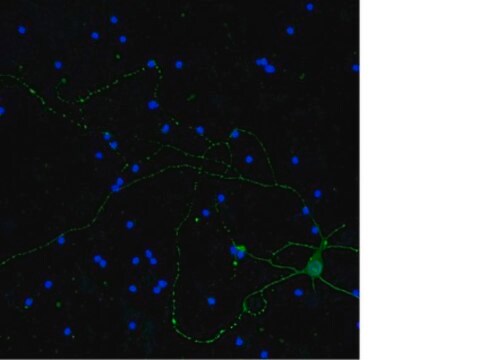MAB5448
Anti-Neurofilament NF-H Antibody, clone TA51
culture supernatant, clone TA51, Chemicon®
Synonym(s):
NF-H
About This Item
Recommended Products
biological source
rat
Quality Level
antibody form
culture supernatant
antibody product type
primary antibodies
clone
TA51, monoclonal
species reactivity
human, rat, hamster, monkey
manufacturer/tradename
Chemicon®
technique(s)
ELISA: suitable
immunohistochemistry: suitable
immunoprecipitation (IP): suitable
western blot: suitable
isotype
IgG
NCBI accession no.
UniProt accession no.
shipped in
dry ice
target post-translational modification
unmodified
Gene Information
human ... NEFH(4744)
rat ... Nefh(24587)
rhesus monkey ... Nefh(717705)
Specificity
Immunogen
Application
Neuroscience
Neurofilament & Neuron Metabolism
Neuronal & Glial Markers
for 1 h at 25°C, and the protein concentrations in the supernatants were determined. Proteins were separated on 7.5% SDS-PAGE gels, {Tu. P et al (1995) J Cell Biol 129:1629-1640}
Immunohistochemistry on frozen sections; not effective on paraffin tissues in original work. {Carden et al, 1987}.
Optimal working dilutions must be determined by end user.
Physical form
Storage and Stability
Legal Information
Disclaimer
Not finding the right product?
Try our Product Selector Tool.
recommended
Storage Class Code
10 - Combustible liquids
WGK
WGK 1
Flash Point(F)
Not applicable
Flash Point(C)
Not applicable
Certificates of Analysis (COA)
Search for Certificates of Analysis (COA) by entering the products Lot/Batch Number. Lot and Batch Numbers can be found on a product’s label following the words ‘Lot’ or ‘Batch’.
Already Own This Product?
Find documentation for the products that you have recently purchased in the Document Library.
Our team of scientists has experience in all areas of research including Life Science, Material Science, Chemical Synthesis, Chromatography, Analytical and many others.
Contact Technical Service







